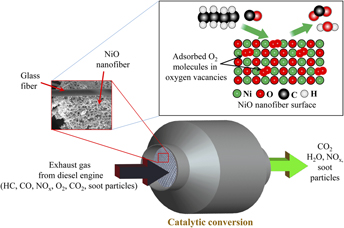Crossref Citations
This article has been cited by the following publications. This list is generated based on data provided by
Crossref.
George, Gibin
and
Anandhan, S.
2014.
Synthesis and characterisation of nickel oxide nanofibre webs with alcohol sensing characteristics.
RSC Adv.,
Vol. 4,
Issue. 107,
p.
62009.
George, Gibin
and
Anandhan, S.
2014.
Electrospun nickel oxide nanofiber webs for thermistor applications.
International Journal of Plastics Technology,
Vol. 18,
Issue. 3,
p.
374.
George, Gibin
and
Anandhan, S.
2015.
Comparison of structural, spectral and magnetic properties of NiO nanofibers obtained by sol–gel electrospinning from two different polymeric binders.
Materials Science in Semiconductor Processing,
Vol. 32,
Issue. ,
p.
40.
Bal’zhinimaev, B. S.
Suknev, A. P.
Gulyaeva, Yu. K.
and
Kovalyov, E. V.
2015.
Silicate fiberglass catalysts: From science to technology.
Catalysis in Industry,
Vol. 7,
Issue. 4,
p.
267.
2016.
Advances in Polymer Materials and Technology.
p.
147.
Bal’zhinimaev, Bair S.
Kovalyov, Eugenii V.
Kaichev, Vasily V.
Suknev, Alexey P.
and
Zaikovskii, Vladimir I.
2017.
Catalytic Abatement of VOC Over Novel Pt Fiberglass Catalysts.
Topics in Catalysis,
Vol. 60,
Issue. 1-2,
p.
73.
Kumar, B. Sachin
Shanmugharaj, A.M.
Kalpathy, Sreeram K.
and
Anandhan, S.
2017.
Some new observations on the structural and phase evolution of nickel titanate nanofibers.
Ceramics International,
Vol. 43,
Issue. 9,
p.
6845.
Sachin Kumar, B.
Kalpathy, Sreeram K.
and
Anandhan, S.
2018.
Synergism of fictitious forces on nickel cobaltite nanofibers: electrospinning forces revisited.
Physical Chemistry Chemical Physics,
Vol. 20,
Issue. 7,
p.
5295.
George, Gibin
Senthil, T.
Luo, Zhiping
and
Anandhan, S.
2021.
Electrospun Polymers and Composites.
p.
689.
Sachin Kumar, B.
Dhanasekhar, C.
Anandhan, S.
and
Kalpathy, Sreeram K.
2021.
Magnetic behavior of polymorph composite nickel titanate nanofibers.
New Journal of Chemistry,
Vol. 45,
Issue. 37,
p.
17438.
DOĞAN, Kemal
HUSSAINI, Ali Akbar
ERDAL, Mehmet Okan
and
YILDIRIM, Murat
2022.
Examining the hydrophobic properties of electrospun oxide-induced polystyrene nanofibers for application in oil-water separation.
International Advanced Researches and Engineering Journal,
Vol. 6,
Issue. 2,
p.
100.
Diao, Fan
Wang, Chizhong
Qiu, Lei
Yin, Yimeng
Zhao, Feilin
and
Chang, Huazhen
2022.
Interaction between Nickel Oxide and Support Promotes Selective Catalytic Reduction of NOx with C3H6.
Chemistry – An Asian Journal,
Vol. 17,
Issue. 17,
Khademakbari, Sepideh
Ebrahimian Pirbazari, Azadeh
Esmaeili Khalil Saraei, Fatemeh
Esmaeili, Amin
Ebrahimian Pirbazari, Ali
Akbari Kohnehsari, Atena
and
Derakhshesh, Ali
2024.
Designing of plasmonic 2D/1D heterostructures for ultrasound assisted photocatalytic removal of tetracycline: Experimental results and modeling.
Journal of Alloys and Compounds,
Vol. 975,
Issue. ,
p.
172994.
Balamurugan, K. S.
Rohini, V.
Minnam Reddy, Vasudeva Reddy
Kim, Woo Kyoung
and
Afzal, Mohd
2024.
Effective photocatalytic degradation of antibiotic chloramphenicol and anionic direct violet 51 dye using g-C3N4 embedded NiO nanocomposite.
Ionics,
Vol. 30,
Issue. 7,
p.
4245.
